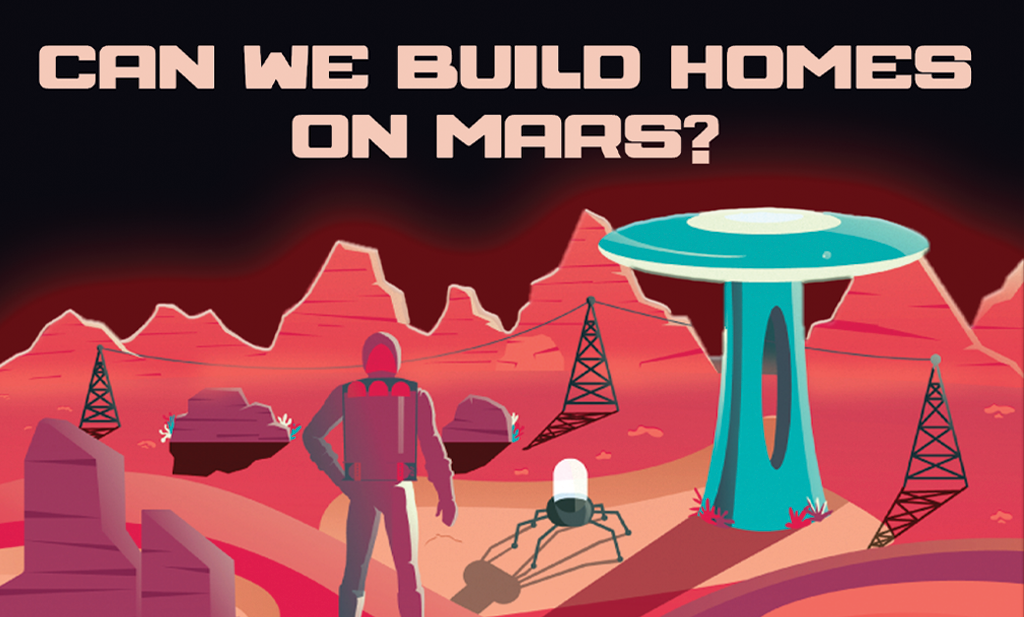A glimpse on building the first structure in Mars

Space-travel is one of the few things that never fails to fascinate a human being. It is the very thrill that perhaps made almost all of us in childhood want to become an astronaut. Some of our favorite movies are based on traveling to the unexplored realms of the universe, be it "2001: A Space Odyssey", the mind-boggling "Interstellar", the ever-fascinating "The Martian" or the fantasy universes of Star Wars and Star Trek – watching the scenery of the places that we can perhaps only imagine in our dreams never failed to amaze us. But the fact is: the advancement of science and technology towards possibilities of venturing into space and the search for the feasibility of living in possible celestial bodies is not only for the sake of mere adventure. The growing environmental concerns that endanger every living species that currently thrive on this planet: rising global temperatures and hence meltdown of poles, rapid depletion of ozone layers due to CFC pollution, the spread of more frequent viral pandemics like the present COVID-19 that has killed more than 350,000 people till May 2020, are to name a few. Humans have claimed to dominate this planet and have been calling this their safe haven, blessed with appropriate temperatures and conditions, but are now being forced to consider options if in any case in future, the planet chooses to wipe out the ever-growing race. Apart from Moon , whether Mars, Venus or Mercury is closest to Earth cannot be exactly said, as their distance varies with time, but with Mercury being super close to the Sun and Venus being extremely hot, Mars seems to be the best alternative planet of Earth, where human beings can continue their hundreds of thousand-year-old multichromatic history.

A glimpse of Tom and Jerry: Blast off to Mars
Martian Concrete – The building block of a structure in Mars
The two options available to human beings for colonisation as of now, are precisely Moon and Mars. The Moon is much closer to Earth, with its average distance from Earth being 384,000 kilometres, while Mars on the other hand, is 54.6 million kilometres away from earth, that too when it is closest to the planet. Thus, on a primary basis, Moon can be considered the best option to initiate a civilisation. However, the conditions on the Moon don't favour human beings much. The near-vacuum atmosphere, drastic changes in temperature and long day-night cycles (about 30 days) will make it extremely difficult for human beings to adapt. Moreover, Sulphur – an ingredient that uses almost zero water, and is proposed as the primary ingredient in interstellar concrete, gets destabilised in the near-vacuum conditions on Moon. In such low pressure conditions, sulphur directly sublimes from solid to gas, thus making it an impossible task to cast sulphur concrete structures on the Moon. On the other hand, Mars eliminates such problems quite smoothly. Almost exact day-night cycles (24 hours and 37 minutes), not so drastic climatic changes, and a precisely favourable atmospheric pressure (0.636 kPa) increase the possibility for the sulphur concretes to retain their strength. Moreover, the surface of Mars is abundant in sources of sulphur, hence its availability won't be a problem.
The most important factor in choosing the concrete type in Mars is theavailability of the material in Mars. The option of hauling the material from Earth would be a disastrous one; a kilogram of material costs 4,000 $ to take it to low Earth orbit, calculate yourselves the cost it would incur to take it across 54 million _kilometres!
Thanks to Lin Wan and his team, a detailed process was elaborated, regarding the construction of Martian Concretes. The idea was to melt sulphur at 240°C, the liquid phase of Sulphur will help in binding the aggregates, a work that is done by water in case of normal concrete. In this way, the disadvantage regarding the absence of water was addressed, which was extremely important, as water is the most important ingredient in concrete that determines almost all the properties of the material.
The fast curing enhanced mechanical and durability properties, and its adaptability with low water contents, coupled with favourable climatic conditions on Mars, make sulphur concrete the best candidate in construction of buildings in a Martian Village. The best results were obtained at a ratio of 1:1 between the Martian soil (Regolith) and the Sulphur. Metals present in the Martian soil would react with the sulphur of the Martian Concretes, forming complexes that would fill up voids and hence enhance the concrete's properties [1]. An interesting fact is, it is even stronger than the concrete we use on Earth, by a factor of about 2.5. Also, it may address some of the issues the present concrete producing industries are facing: high CO2 footprints. Since Martian concrete can be molten down and reused again and again, it may turn out to be one of the most energy-efficient products ever made in human history. In short, a Martian Concrete used in constructions on Mars will be of a much higher standard, when compared to the ones used on Earth [2].

Basic composition of Martian Concrete
How will the construction happen in Mars?
One of the main challenges, however, would be how to build those structures? Surely, a manned mission to Mars is still yet to materialise, let alone constructing structures manually on the planet. However, Robert P. Mueller has initiated a 3D-Printed Habitat Challenge, which offers $2.5 million to any scientist who discovers a way to build structures on Mars. An advanced version of 3D-Printer which can utilise the naturally available resources on the planet to construct a pre-programmed design in a completely automated way is the best option available as of now.

The plan, outlined by SEArch+ and ApisCor
Picture Credits: Teams SEArch+/ApisCor
Lately, New York Space Architects SEArch+ partnered with a Californian 3D-printing construction company ApisCor and came up with a building plan for Mars having all basic comfort facilities, all constructed with Hercules , a reusable spacecraft, as its base, which would carry all the life-sustaining materials to the planet.
Concave walls will be used to help in maintaining the pressure, to enable breathable conditions. Also, series of insulation layers will be constructed, to prevent the people living within the buildings from harsh climatic conditions.
Hercules is a transportation system capable of bringing cargo and passengers to the Moon, Mars, and more. It is built for reusability, commonality, operational flexibility, and crew safety beyond the performance and efficiency standards of other planetary lander system concepts.
Source : Nasa
Constructing buildings using 3D-Printing technology isn't something that hasn't been tried. In fact, ApisCor has already constructed a one-storey building in the Russian town of Stupino in the span of just 24 hours. In the case of Mars, an estimated construction time is 52 hours [3]

A 3D-printed building in Russia by ApisCor
Picture Credits: ApisCor
Another use of 3D-printing for Martian constructions is being researched by the scientists involved in The Mars Ice House project, who suggest creating structures primarily out of Martian Ice. Subsurface ice, evidence of which has been found through several Mars Rovers, would be converted into liquid water via vapour state, which will then be used to print solid structures. The cold environment will then instantly convert it into ice.
For more of this amazing project, visit https://www.marsicehouse.com
But hold on! Mars is not just another Earth.
Although Mars is the best possible option for human beings to live after Earth rejects them, there are a number of issues that may threaten the existence of our species [4].
- One of the main problems would be the unavailability of water. For a species that uses 70-140 litres per person per day on average, the absence of water may prove to be fatal. Although subsurface ice presence has been detected, any trace of usable water on the surface of Mars is yet to be found. Hence, we must explore proper mechanisms to trigger the production of water artificially at a scale large enough to sustain the human race.
- Difference in gravity will affect bones and tissues.
- Absence of a thick magnetosphere like Earth exposes the planet to harmful solar radiations, which may increase the risk of cancer and other inflammatory diseases. Thus, either the civilization must thrive under an artificial protective layer, or in underground lava tubes.
- Absence of soil may prove costly. Agriculture may become a thing from fiction, with human beings becoming largely dependent on chemically produced food products.
- Communication delay while communicating from Earth to Mars may prove to be troublesome. Light takes 3 minutes to travel from Earth to Mars, and hence, a minimum of 3 minutes delay is expected.
So, possibility of a Mars Civilisation is no longer just limited to Tom and Jerry!

Earth-like structures dominating the landscape of Mars may not be just a piece from fictions in future.
Picture Credits: World Economic Forum
With the given advancements in science and technology, and the never-ending thirst of human-race to venture more and more into the unexplored realms of science, some things that maybe about 10 years ago were just limited to fiction, may find their place in reality. Manned missions to Mars may not happen in the near future, but automated construction technologies, like the above-mentioned 3D printing technologies, may enable us to construct structures on Mars without being physically present. However, as we progress towards colonising Mars, we must not forget that the ideal conditions for existence of life, as on Earth, may not be present anywhere in this vast universe. While Mars may be a distant future option for humanity to thrive, we must increase our devotion towards protecting this planet which has been home to us for more than 200,000 years.
References:
- Wan, Lin. Wendner, R. Cusatis, G. A novel material for in situ construction on Mars:experiments and numerical simulations. Construction and Building Materials 120 (2016). 222-231.
-
Why Martian Concrete Might Be The Best Building Material In The Solar System url : https://www.fastcompany.com/3055172/why-martian-concrete-might-be-the-best-building-material-in-the-solar-system
-
Is this 3D-printed building the future home for astronauts on Mars? url: https://www.weforum.org/agenda/2019/04/this-3d-printed-martian-home-is-truly-out-of-this-world/
- Colonization of Mars. url: https://en.wikipedia.org/wiki/Colonization_of_Mars#Conditions_for_human_habitation


 Never miss a story, subscribe to our newsletter
Never miss a story, subscribe to our newsletter